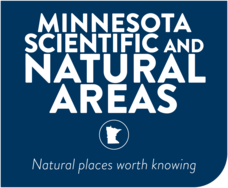|
Summer 2020

Nature Notes is the Minnesota Scientific and Natural Areas quarterly newsletter. Here's what's in store this issue!
|
The Rare and Wild: Saline Prairie
Learn more about one of the rare native plant communities that Scientific and Natural Areas protect in this 2020 series about the “Rare and Wild” in Minnesota!
Fred Harris, Minnesota Biological Survey
If you cross low, wet ground between the shorelines left by glacial Lake Agassiz in some of Northwestern Minnesota’s large prairie preserves, you might find thinly vegetated zones with whitish salt deposits on the soil surface. You may be surprised to learn this is a specific type of wet prairie: saline prairie, one of the rarest and least-studied prairie types in Minnesota.
Highly saline spot in a Polk County Prairie. Photo by Fred Harris.
What is saline prairie?
Saline prairie forms in the western part of Minnesota within calcareous (calcium-carbonate-rich) deposits left by a massive tongue of glacial ice (the Des Moines lobe) that covered the region over 11,000 years ago. One such landscape is the zone of gravelly ridges marking the former shores of glacial Lake Agassiz. These beach ridges and inter-beach zones are especially conducive to saline prairie formation because they lie on a gradually sloping land surface. Groundwater becomes enriched in minerals as it percolates horizontally through the calcareous deposits and emerges farther downslope. Evaporation of the groundwater concentrates the minerals at the surface.
The elevated salt content of the soils creates extreme growing conditions where only salt-tolerating (“halophytic”) plant species grow. As a result, saline prairie is less diverse than other prairie types, but contains several species found nowhere else in the state. You can often spot these areas of high soil salinity from a distance because they are typically marked by the feathered seed heads of foxtail barley grass (Hordeum jubatum) waving in the breeze. Other dominant species include very slender sedge (Carex praegracilis), also called freeway sedge because it shows up in accumulations of road salt; scratchgrass (Muhlenbergia asperifolia), forming fluffy white or pinkish clouds of seed heads; and little bluestem (Schizachyrium scoparium). Strongly saline areas are packed with salt grass (Distichlis spicata), a relatively short grass with straw-colored seed heads when mature.
What else grows here?
Several rare plants grow in saline prairie, many of which are Great Plains species at the very eastern edges of their U.S. distributions in western Minnesota. These include grasses or sedges, such as: alkali cordgrass (Spartina gracilis), which is shorter and more narrow-leaved than the common prairie cordgrass; Hall’s sedge (Carex hallii), forming stiff, nearly leafless stems topped with 2-3 cylindrical spikes; and Plains bluegrass (Poa arida), which is similar to but more robust than the non-native Kentucky bluegrass (Poa pratensis).
Plants to look for include: seaside arrowgrass (Triglochin maritima), known for its succulent leaves that exude a strong, musky scent of cilantro (from a cyanide compound) when crushed; alkali plantain (Plantago eriopoda), which forms clumps of narrow, leathery, strongly-veined leaves with reddish bases; and alkali buttercup (Ranunculus cymbalaria), growing in diminutive clumps with tiny yellow flowers. One of the rarest and most rewarding saline prairie forbs to find in the Agassiz beach ridges is the northern gentian (Gentiana affinis) which typically hides among the grasses in late summer, its blue flowers dotted with pale freckles.
Northern gentian (Gentiana affinis). Photo © Otto Gockman.
Where is it in Minnesota?
In the Agassiz beach ridges; look for saline prairie on the east sides of marshes. Places to go include the Crookston Prairie Unit of the Pembina Trail SNA in Polk County; Twin Valley Prairie SNA and Sandpiper Prairie SNA in Norman County; and Western Prairie SNA in Clay County. Other locations in Polk County include the Nature Conservancy’s South Unit of the Pankratz Memorial Preserve and the Dugdale State Wildlife Management Area.
In southwestern Minnesota, saline prairie is much harder to find. It occurs in drainages that run along the northeast edge of the Prairie Coteau, in western Lac Qui Parle and Yellow Medicine Counties, and in the upper Minnesota River valley. A good place to see it is in the Antelope Valley SNA located just southeast of Canby--if you go, look for low swales in the former hay meadow in the southeast corner of the SNA.
Saline Prairie at Twin Valley Prairie SNA. Photo by Fred Harris.
To the casual observer, saline prairie may not look like much to crow about. However, to the informed observer, these prairies are an intriguing part of the diverse array of habitats that make up our prairie landscape.
Back to top
|